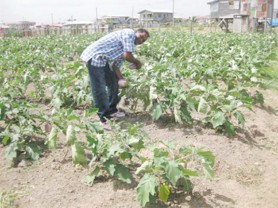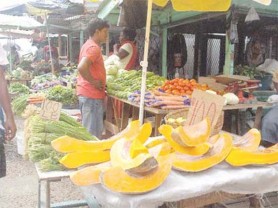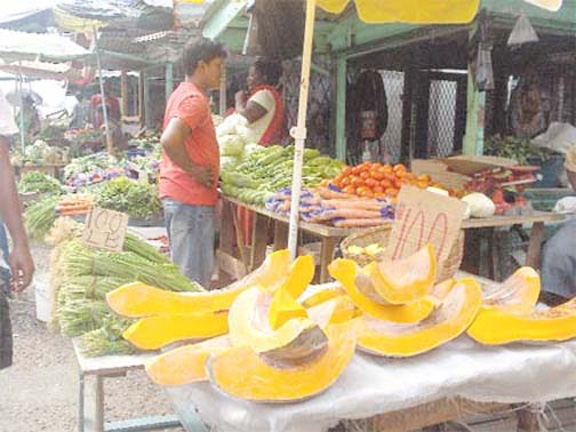–ministry says exports doubled since 2006
Shortly after the return to office of the PPP/C government in 2006, Agriculture Minister Robert Persaud announced an ambitious drive to boost food production by focusing on the 4 ps: pineapple, peanuts, plantains and passion fruit and this later evolved into the broader Grow More Food Campaign. Has it worked? Has the investment in these campaigns produced a commensurate increase in output which has pumped up exports and lowered the import bill? Stabroek News set out to determine this by speaking to the Agriculture Minister and visiting major farming communities around the country. A major tool needed in the assessment is the provision of detailed data from the ministry setting out the year on year changes in the output for the major non-traditional crops and export quantities along with the amount invested. This has not yet been provided. This is the first part in a series by Stabroek News examining the non-traditional agricultural sector and the grow more food campaign.
The Ministry of Agriculture cites a near doubling of exports of non-traditional agricultural products since 2006 but is the quantum of the increase a major stride and commensurate with the amount of money invested? Producing for the export market is the “next leap” in the non-traditional agriculture sector, Agriculture Minister, Robert Persaud said, and he identified agro-processing as a critical need as production rises.
The aim is no longer about producing what Guyana requires, he said adding that the “next leap” has already begun. Guyana is positioning itself to be a leading food producer in the region and a major exporter of not only fresh food but ultimately processed products but for the time being, the emphasis is on fresh produce, he said in a recent interview with Stabroek News.

Production has gone up significantly, Persaud said. For the first half of this year compared to the same period last year, the non-traditional agriculture sector expanded by as much as 50%. He added that this was remarkable particularly given the drought-like El Nino phenomenon experienced earlier this year. Persaud attributes the growth to the investments in the sector by government. No figures on annual investments in the grow more food campaign were provided.
According to figures provided by the ministry, in 2006 exports of non-traditional agricultural commodities were 5219 tonnes. In 2007, this rose to 7394 tonnes, dropping in 2008 to 7116 tonnes. It rose to 9423 tonnes last year and from January to July this year, exports stood at 7308 tonnes.
In 2006, Persaud articulated a vision for a larger, more vibrant agriculture sector. The campaign aimed to ensure Guyana’s continued security in food and also contribute to regional food security. Four years later, Persaud said that production and exports have risen significantly. He pointed out that Guyana is a net exporter of food, exporting more than it imports. He said exports have jumped up to considerable levels; in some instances the percentage change is as much as 600% in recent times. The minister acknowledged that in some instances, figures have dropped but said that this is seasonal. “But it has been so much that it’s come up with a percentage change by as much as 34.8% increase,” he said, referring to the first half of this year compared to the same period last year.

He admitted that there are problems that remain to be addressed identifying market access, logistics, and for farmers, reliability in terms of quantity and quality, as the main
hindrances to exports. The need to ensure that the purchasers maintain a high level of commitment to the activities is also vital, Persaud added. He pointed out that shipping and transport logistics is a major problem saying that this is why the administration is examining options, including new airlines. Other constraints to the sector include processing, infrastructure, climate change and international commodity prices, he said.
Despite the billions ploughed into the sector annually, many farmers say the lack of markets remains a major concern. Persaud highlighted the Inter-American Development Bank (IDB) funded, Agricultural Export Diversification Programme (ADP) as the vehicle to move the sector to another level. “This project has really commenced implementation this year,” he said.
He outlined that the ADP is about modernisation to ensure international standards so that markets like Europe and the US can be accessed. It is not only about production but also covers the setting up of plant and animal health systems, the creation of clusters and providing the necessary facilities and infrastructure for farmers and processors, Persaud said. The ADP is export driven; it is about processing, providing credit, grant assistance, building new labs and new systems. “It’s a very holistic programme which is complementing what we are doing through our own budgetary resources,” Persaud said. But, he pointed out, the programme is now getting off the ground and the results from the investments won’t be seen for a couple of years though there are activities for “early take-off”.
Clusters
The strategy involves developing three main clusters: fruits and vegetables, livestock, and aquaculture; and the project is moving smoothly in terms of developing these, Persaud said. Working groups involving the private sector working with agencies in developing the system and identifying what the needs are, are in place, he said. In terms of infrastructural projects, some have started but “much more has to be done in that regard,” he said adding that many activities are taking place.
However, at present, farmers continue to express concern about the limited markets which sometimes force them to leave crops in the fields because prices are too low. The revamped role of the New Guyana Marketing Corporation (GMC) is to link farmers to buyers and not to do the buying, Persaud said. Farmers are also being encouraged to do market surveys and assessments, with which the GMC can help, before they undertake activities, he said.
The minister stated that markets are very important but pointed out that there are seasonal gluts saying that a competitive processing sector is badly needed to utilize the excess. The government is not, at this point, looking to get into processing, he said. “It’s for the private sector. Our role: we are hoping through the ADP to assist in providing financing for small cottage industries in this regard,” said Persaud. “But it is a critical need and we’ve identified that. But the cost of energy has been an inhibitor to a processing sector,” he added. He pointed out that because of the high energy costs here, products can be imported and sold at a better price “because we are not competitive”.
He said that the administration is hoping, with the hydro-power project coming on stream, a viable processing sector can be developed “because we cannot talk about having agriculture diversification and massive growth in agriculture if we don’t look at agro-processing”.
The minister emphasized that despite the hindrances being faced; there has been a consistent growth not only in production but in exports. “There is a lot of unofficial exports taking place – in Suriname; going off from the Pomeroon and different areas – which we don’t get, which we don’t document so it can be much greater than this,” he added. He said they have been able to identify new markets for fresh produce but admitted that this will take time to build. At the same time, production must be ramped up because if markets are secured, the farmers must be able to supply the produce, he said.
He pointed out that packaging plants have been set up and the cold storage facility is being developed. “An exporter doesn’t have to go and invest in cold storage. We have it. An investor doesn’t have to go and invest in a packaging plant. You come and you use our packaging plant. A farmer doesn’t have to worry that he has nowhere to go and bring his produce so that it can be prepared. We have developed that facility,” Persaud said. “It’s a very holistic approach, database, the linkage, helping with the processing, the packaging, helping with the export requirements, opening new markets and then it goes through the different components.”
As it relates to farmers producing to the standard demanded by international markets, Persaud said the ADP addresses this in terms of training farmers, assisting them to produce better quality crops, and good agriculture practices so that farms can be certified. He expressed confidence that the farmers would be able to meet the standards required and said the ministry will work with them on meeting the standards required for export. The New GMC will be stepping up its market identification activities and has planned a series of export outreaches in the Caribbean and in North America, he added.
Meantime, the acreage under cultivation has increased and in many areas there is a lot of pressure for more land, the minister said identifying Parika Back as one such area. New land is being opened on the Essequibo Coast, in Amerindian communities, in the Pomeroon, in Berbice and on the East Coast Demerara, where a land clearing programme is ongoing, he said.
Guyana continues to import some produce that can be grown here such as cabbage and the tightening up on this continues, Persaud said. He pointed out that Guyana is food self sufficient apart from wheat and things that are not produced here such as apples, grapes, potatoes, onions and garlic. However, as it relates to onions and garlic, a project is ongoing in Region Eight, where the climate is more temperate and the soils better suited for these types of crops. There are some activities that the ministry is looking to resuscitate in the region but that is dependent on the road link being established, which will not happen anytime in the near future, Persaud said.
Increased responsibility has been placed on the National Agriculture Research Institute (NARI) in recent times and Persaud said it has been doing a fair job but there is still room for improvement. Capability is being built, he stressed saying that the institute is not at the ideal or level it ought to be at but it is being built and they are looking at Cuban-trained professionals working with NARI.
One responsibility is about to be removed, however. “The livestock aspect of NARI will be separated soon and will be brought under the Guyana Livestock Development Authority so that will take away all the livestock so it can concentrate on crop development and crop production,” Persaud disclosed.
Among other projects, NARI is overseeing one aimed at producing spices for local markets. This is doing well and more farmers are getting involved, Persaud said. “It’s at a stage where farmers can now access the technology we have and the support and there’s a ready market.” Corn too, for which there is a ready market, is being encouraged, particularly in the hinterland areas, he added.
Persons have called for the North-West seaside community of Morawhanna to be made an official port, as it would be easier to export from there to the market in Trinidad and Persaud said they are waiting for this to be taken up by the private sector. The government is ready but needs someone to operate it,” he said pointing out that the government had advertised for an operator for an export facility and one man had gotten involved but then he stopped, so an operator is still being sought.
On crop insurance, the minister said that government is committed to this and discussions are continuing with the World Bank. He said there have been several meetings with private insurance companies and interactions with the Inter-American Institute for Cooperation on Agriculture (IICA) and talks are ongoing as government is “aggressively” pushing this initiative.

